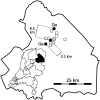Outbreeding depression and breeding system evolution in small, remnant populations of Primula vulgaris: consequences for genetic rescue
- PMID: 31007635
- PMCID: PMC6448329
- DOI: 10.1007/s10592-017-1031-x
Outbreeding depression and breeding system evolution in small, remnant populations of Primula vulgaris: consequences for genetic rescue
Abstract
Many species suffer from anthropogenic habitat fragmentation. The resulting small and isolated populations are more prone to extinction due to, amongst others, genetic erosion, inbreeding depression and Allee-effects. Genetic rescue can help mitigate such problems, but might result in outbreeding depression. We evaluated offspring fitness after selfing and outcrossing within and among three very small and isolated remnant populations of the heterostylous plant Primula vulgaris. We used greenhouse-grown offspring from these populations to test several fitness components. One population was fixed for the pin-morph, and was outcrossed with another population in the field to obtain seeds. Genetic diversity of parent and offspring populations was studied using microsatellites. Morph and population-specific heterosis, inbreeding and outbreeding depression were observed for fruit and seed set, seed weight and cumulative fitness. Highest fitness was observed in the field-outcrossed F1-population, which also showed outbreeding depression following subsequent between-population (back)crossing. Despite outbreeding depression, fitness was still relatively high. Inbreeding coefficients indicated that the offspring were more inbred than their parent populations. Offspring heterozygosity and inbreeding coefficients correlated with observed fitness. One population is evolving homostyly, showing a thrum morph with an elongated style and high autonomous fruit and seed set. This has important implications for conservation strategies such as genetic rescue, as the mating system will be altered by the introduction of homostyles.
Keywords: Fitness; Heterosis; Heterostyly; Homostyly; Inbreeding depression; Restoration biology.
Figures




References
-
- Allendorf FW, Luikart G, Aitken SN. Conservation and the genetics of populations. 2. Chichester: Blackwell Publishing; 2013.
-
- Boyd M, Silvertown J, Tucker C. Population ecology of heterostyle and homostyle Primula vulgaris: growth, survival and reproduction in field populations. J Ecol. 1990;78:799–813. doi: 10.2307/2260900. - DOI
-
- Curtis J, Curtis CF. Homostyle primroses re-visited. I. Variation in time space. Heredity. 1985;54:227–234. doi: 10.1038/hdy.1985.30. - DOI
LinkOut - more resources
Full Text Sources
